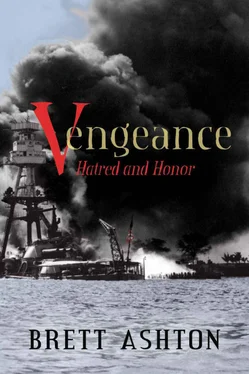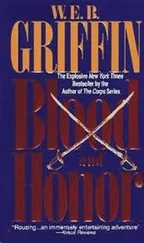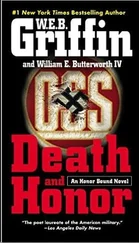As the day progressed, we would come across more Japanese in the water. Some stripped as requested and were brought aboard, but many got shot trying to swim away.
“It serves them right after Pearl,” I thought to myself as I watched from the open bridge. “It was me they were trying to shoot as I was defenseless in the water just a few years ago. If that’s the way they want to play it, that’s the way we will play it. I don’t care if I have to personally shoot every single Nip in the Japanese navy myself; I am not losing another of my crew to these suicidal freaks if I can help it.”
And at that point, I still could never have guessed what was going to happen next. Nobody could have.
“Sir,” the bridge talker said “CIC is reporting incoming bogies.”
“Battle stations,” I replied. And for the third time that day, the Buffalo prepared for an air attack.
I think sometimes they would do this kind of thing on purpose to try to wear us out. I personally called it “Crying Wolf.” They would let us spot them while they were far out so we would brace ourselves, and then they would turn the other way. Sometimes they would appear and disappear on our radar like ghosts. It was kind of nerve-wracking because you could never really tell which one was going to be the real attack. And if you were in an area of sparse air cover like we were that afternoon, it was outright maddening.
We changed course to get the most of the ship’s guns pointed toward the oncoming aircraft and accelerated to flank speed.
There was a formation of aircraft at an extremely high altitude coming in straight and fast. I had the talker give off the ranges as they came in and instructed the gun boss to open fire as soon as they came within range. There were a lot of them, so I decided to engage them with the ship’s six-inch guns as well.
I began to see the guns turn toward the targets as the ship prepared for battle. I pulled out my forty-five and checked it again. It was loaded and ready, as was the Buffalo .
I grabbed my binoculars to try and spot the incoming formation, and when I couldn’t see them, I asked the talker what altitude they were at. Something felt wrong. They were staying very high, whereas normally, they would have dropped down to a more adequate level for a dive-bomb attack with a simultaneous torpedo attack.
I passed the word for the watches and CIC to watch for another formation of aircraft, suspecting this one was going to be a distraction.
A very short time later, several things happened almost all at once.
The talker shouted, “ Bogies bearing one eight zero, closing fast! ” Just about then, the aft starboard side five-inch gun opened fire, seeing incoming aircraft and not waiting for any other order to open fire. And realization occurred about what the Japs were doing. They were keeping our attention up high to the port side where most of our guns were currently pointed, and they also had some aircraft coming in low, under the radar, so we couldn’t see them. And by spreading the attack out over ninety degrees, either way I turned the ship, I would have to divide the ship’s guns between the two formations. It was a very well executed attack.
I had to make a call quickly, so I ordered “ Hard starboard rudder! ”
The ship rapidly turned to meet the two formations of attackers and the appropriate guns swung around to greet them as well. Tracer fire rapidly began to erupt from the starboard guns as the ship came about, but something still wasn’t right. These Japs were coming in low, two of them almost right on the water, and very, very fast, much too fast and low for a torpedo attack. “What are they doing?” I said out loud, my senses telling me something was dreadfully wrong.
Several of the guns on the port side opened fire on the high altitude formation. Two of them had begun a diving attack of some kind, but the angle wasn’t nearly steep enough for a dive-bomb run, and they were still too far away to get the right angle to release a bomb on target.
One of the aircraft in the formation to the aft erupted into a ball of flame, skipped across the water, and exploded. The other started trailing smoke, the normal point where a damaged aircraft would turn back, but this one kept coming with all of its guns blazing and a bomb on the bottom of it.
The two attacks were being timed out, high and low, so the attack was continuous and keeping the guns of the ship pointed in different directions; that was obvious. But they were not lining themselves up for any normal use of weapons that I could see. There would be no chance of hitting a ship with a bomb from either of those altitudes, angles, and speeds, and have the aircraft which dropped it still survive the blast.
The two high-approaching aircraft were coming in closer and pushed over into a steeper dive that was still too shallow to drop a bomb. They were moving extremely fast.
Wild cyclones of automatic weapons fire spun up from the ship as the Buffalo reached its maximum potential of firepower.
The gunners on the starboard side converged their fire on the remaining aircraft as it sped toward us. A wing ripped loose from it, rolling over violently and splashing into the sea, just off of the starboard side of the ship. Its bomb exploded, raining shrapnel down over the open decks.
“It should have turned back long before that,” I said to myself. “And why was an aircraft attacking so low loaded with a bomb?”
Just then, one of our guns must have hit a bomb on one of the high altitude attackers because it blew up and showered debris down into the sea several hundred feet from the ship. The other one spun out of control and hit the water about fifty feet from the fantail.
Several more from the high altitude formation broke loose in a pattern that looked like a typical dive-bomb attack. So I put the ship in another starboard turn to lower our profile toward them, but just as that happened, several more low altitude aircraft sped toward us from the aft side of the ship.
These were Val dive bombers; why would they be coming in low like this?
The two high altitude bombers, both Judys, missed the ship by a pretty wide margin, evidently because of inexperienced pilots. But the Vals, apparently loaded with bombs, kept coming straight on.
Once again, the Buffalo ’s guns cut them to ribbons, this time at a safer distance out, but it was still very disturbing. “What on God’s Earth are they doing?” I said to myself.
The attack continued like this several more times at a very rapid but even pace. The Japanese would sometimes actually drop their bombs but we were lucky to be missed each time. This was either because of the poor skill of the Japanese pilots or the superb skill of the Buffalo ’s crew.
But mixed into the shifting formations of attacking aircraft, there were always several coming in either at angles much too steep to drop their bombs or much too low. And those ones always came in very straight and very fast, and would keep coming even after you hit them, until you completely destroyed them. Those were the ones that absolutely scared the ever-living daylights out of me.
Sometime during the fourth or fifth wave of these attacks, my attention turned toward one of the escorting destroyers. They were under furious attack as well, and I thought maybe I could figure out what the Japs were doing if I watched them from a different point of view.
A Val dive bomber broke loose from the high altitude formation and began a shallow dive. There was, as before, no way to release a bomb from that angle and hit a target. At an altitude of about five thousand feet, he pushed his aircraft over into a very steep dive. The anti-aircraft guns on the destroyer had hit him several times by then, and the aircraft was trailing smoke. There was no way to release a bomb at that angle and speed and expect it to land on target, let alone pull out of a dive like that without the pilot losing consciousness.
Читать дальше












